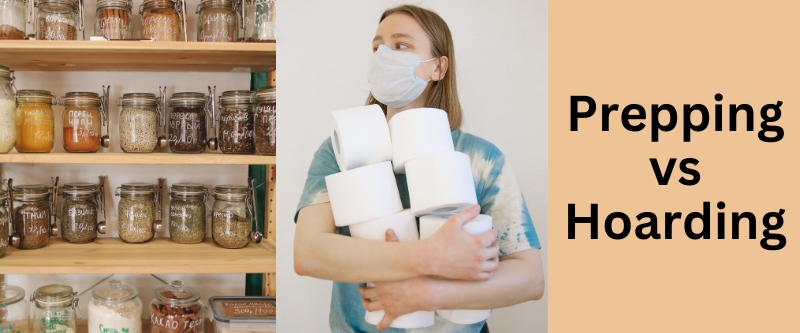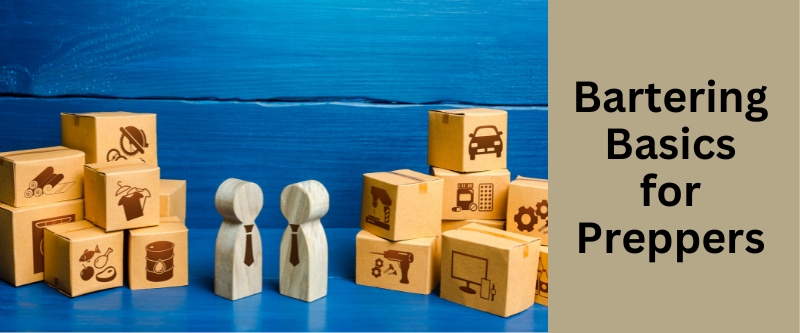Table of Contents
Introduction
The concepts of prepping and hoarding often intertwine, leading to confusion and misconceptions. While both involve accumulating things, their motivations, methods, and outcomes differ vastly.
This article aims to shed light on these differences, helping readers discern between a responsible prepper and a compulsive hoarder. So, we’ll explore the nuances of each approach, the benefits of prepping, the pitfalls of hoarding, and the fine line that separates the two. ANd we touch on two different types of hoarding.
So, whether you’re a seasoned prepper, someone accused of hoarding, or simply curious about the topic, this comprehensive guide is tailored for you. So, let’s embark on this enlightening journey and demystify the world of prepping vs. hoarding.
Key Takeaway
Meaning of Prepping
Prepping is the process of responsibly and methodically preparing oneself and one’s family by accumulating a supply of necessities in advance against possible future natural or manmade disasters. This may indeed be a large supply necessary to last a full year of more.
Dual Meaning of Hoarding
Hoarding has two meanings, clinical and socio-political:
- The first describes a psychological compulsion to accumulate stuff and never let it go. This can range from mild eccentricity to a mental disorder.
- The second meaning refers to the predatory panic buying of large quantities of supplies (such as toilet paper) in the face of a known imminent disaster. This might be a looming hurricane or the onset of a pandemic.
The problem for the long-term, methodical prepper is that, in a SHTF scenario, he can get accused of hoarding in this second sense.
What is Prepping?
Prepping, at its core, is the act of preparing oneself and one’s family for potential future emergencies. This could range from natural disasters like hurricanes and earthquakes to man-made crises such as economic downturns or even societal collapse. The essence of prepping lies in its proactive nature; it’s about anticipating potential threats and taking steps to mitigate their impact.
Benefits of Being a Prepper
- Self-sustainability: Preppers often focus on skills and resources that allow them to be self-reliant. This includes growing their own food, collecting and disinfecting water, and even generating their own power.
- Peace of Mind: Knowing you’re prepared for various scenarios provides a sense of security and reduces anxiety related to the unknown.
- Economic Savings: By stockpiling supplies when they’re on sale or available in bulk, preppers can save money in the long run.
- Community Building: Many preppers are part of larger communities where they share knowledge, resources, and support.
There is a useful discussion here:
Hoarding vs Prepping
What is Hoarding?
Hoarding is a behavioral disorder characterized by the excessive acquisition of items, even if these items are worthless, hazardous, or unsanitary. Unlike prepping, which is driven by clear purpose and intent, hoarding often stems from an emotional or psychological compulsion. It’s not just about having a lot of stuff; it’s about an inability to let go, even when these possessions clutter living spaces and impede daily life.
Characteristics of Hoarding
- Emotional Attachment: Hoarders often form deep emotional connections to their possessions, making it challenging to discard even trivial items.
- Disorganization: Unlike preppers who prioritize organization, hoarders often have cluttered spaces where items are not stored in any logical or functional manner.
- Denial: Many hoarders don’t recognize or accept that they have a problem, even when their living conditions become hazardous.
- Isolation: Due to the stigma associated with hoarding, many hoarders become isolated from friends and family, further exacerbating the issue.
Prepping vs Hoarding
While both prepping and hoarding involve accumulating items, their motivations, methods, and outcomes are starkly different. Here’s a breakdown of their primary distinctions:
Purpose and Intention
- Prepping: Driven by a clear goal to ensure safety and sustainability during emergencies. Every item in a prepper’s stockpile has a specific purpose and use.
- Hoarding: Often lacks a clear rationale. Items are accumulated due to emotional attachments or compulsions, regardless of their utility.
Organization vs. Chaos
- Prepping: Emphasizes organization. Supplies are systematically stored, rotated, and checked for expiry. Spaces are optimized for easy access and functionality.
- Hoarding: Spaces are cluttered and disorganized, making it difficult to locate or use items when needed.
Value of Items
- Prepping: Focuses on stockpiling valuable and essential items like food, water supplies, medicine, and survival equipment.
- Hoarding: Accumulates items indiscriminately, often including non-valuable or even trash items.
Response to External Events
- Prepping: Proactive and informed. Preppers often adjust their strategies based on current events, ensuring they’re prepared for various scenarios.
- Hoarding: Reactive and often driven by panic buying. Hoarders might suddenly accumulate items due to fear, even if they have no immediate use for them.
Community Interaction
- Prepping: Many preppers are part of larger communities, sharing knowledge and resources. They often engage in group activities and drills.
- Hoarding: Tends to be a more isolated activity, with individuals distancing themselves from friends and family.
When Does Prepping Become Hoarding?
It’s essential to recognize that there’s a fine line between being a well-prepared individual and slipping into hoarding tendencies. While the core principles of prepping revolve around foresight, organization, and practicality, there are instances where even the most seasoned preppers might find themselves on the verge of hoarding.
Signs to Watch Out For
- Over-purchasing without a plan: Buying supplies without a clear storage plan or without considering their shelf life can lead to waste and clutter.
- Emotional distress when discarding items: If letting go of expired or unnecessary items causes significant emotional turmoil, it might be a sign of hoarding tendencies.
- Compulsive buying: Continuously purchasing items without a clear need or purpose, especially during sales or discounts, can be a red flag.
Here is another take on prepping vs hoarding:
The Danger for Preppers
In a SHTF (Sh*t Hits The Fan) scenario, a wise prepper who has responsibly prepared might face accusations of being a hoarder. This can lead to social ostracization, potential legal issues, or even theft. Here’s what a prepper should do in such situations:
- Stay discreet: Avoid flaunting your supplies or discussing your stockpile with those who might not understand prepping.
- Engage in community prepping: Building a community of like-minded individuals can offer support and understanding, reducing the chances of being labeled a hoarder.
- Educate and share: If faced with accusations, take the opportunity to educate others about the importance of prepping. Sharing knowledge (and sometimes supplies) can help change perceptions.
On the other hand of course, engaging in the prepping community is tantamount to advertising that you have “stuff” stashed away. And it may be putting a target on your own back. In this, only you can be the judge of your own individual circumstances.
I will only say that desperate times make for desperate people. And, if word gets around that you have supplies, there are those who will take them from you. And, if they can’t find them and and you don’t give them up, they will torture your wife until you do.
The Role of Current Events
In an ever-evolving world, current events play a pivotal role in shaping behaviors, especially when it comes to prepping and hoarding. From natural disasters to global pandemics to world wars, events can trigger a range of responses in individuals.
How Global Events Influence Behaviors
- Media Coverage: Sensationalized news stories can lead to panic buying, where people rush to stores to stock up on essentials out of fear. This reactive behavior is more aligned with hoarding than prepping.
- Economic Fluctuations: Economic downturns or uncertainties can push individuals to prep as a form of risk mitigation. They might stockpile essentials fearing price hikes or shortages.
- Natural Disasters: The aftermath of hurricanes, earthquakes, or floods often highlights the importance of being prepared. Such events can lead to a surge in prepping activities as people realize the value of having essential supplies on hand.
- Political and Social Unrest: Political upheavals or societal tensions can make individuals apprehensive about the future, prompting them to prep for potential disruptions.
The Danger of Misinterpretation
While preppers use current events as a guide to adjust their strategies and ensure they’re prepared for various scenarios, the general public might misinterpret their actions. For instance, during a crisis, a prepper’s well-organized stockpile might be seen as hoarding by others, leading to potential conflicts or accusations.
Navigating the Current Landscape
For preppers, it’s essential to stay informed but also critical of the information they consume. Distinguishing between genuine threats and media hype can help them make informed decisions. Additionally, engaging in community discussions and sharing knowledge can help dispel myths and foster a better understanding of prepping in the broader community.
Prepping in History
As a prepper, don’t think for a minute that you are out of step with the mainstream and some kind of weirdo.Prepping is as ancient as man. Here is an interesting piece on prepping from a Biblical Perspective. And here is some more recent history.
Tips for Responsible Prepping
Being prepared for unforeseen circumstances is commendable, but it’s crucial to approach prepping responsibly. Here are some guidelines to ensure that your prepping endeavors are both effective and sustainable:
Creating a Prepping Plan
- Assess Your Needs: Before stockpiling, evaluate your family’s specific needs. Consider dietary restrictions, medical requirements, and the number of people in your household.
- Set Clear Goals: Determine what you’re prepping for. Is it a short-term power outage, a longer-term economic downturn, or a natural disaster? Tailor your supplies accordingly.
Setting Limits
- Budget Wisely: Allocate a specific budget for prepping each month. This ensures you don’t overspend and can maintain your regular financial obligations.
- Space Considerations: Be mindful of the space you have. Overcrowding can lead to disorganization, which defeats the purpose of prepping. By the same token, if you don’t have enough space, reconsider your entire situation.
Regularly Reviewing and Rotating Supplies
- Check Expiry Dates: Regularly review your stockpile to ensure items haven’t expired. Rotate supplies, using older items first.
- Update Equipment: Ensure that tools and equipment are in good working condition. Replace batteries, sharpen knives, and check the functionality of gadgets.
Stay Educated
- Continuous Learning: The world of prepping is vast. Stay updated with the latest survival skills, techniques, and equipment. Attend workshops or join online forums.
- Practice Scenarios: Periodically, simulate emergency situations to test your preparedness. This helps identify gaps in your plan.
Engage with the Prepping Community
- Share and Learn: Engage with fellow preppers. Sharing experiences and knowledge can be invaluable. It also helps in building a support system.
- Group Purchases: Consider bulk buying with other preppers. It can be cost-effective and allows access to wholesale rates.
Be Cautious
We have already touched on the potential danger facing a prepper in a SHTF situation, when society may have broken down. So don’t let altruism get in the way of self-preservation. Take security measures to protect your supplies.
Conclusion
In a world filled with uncertainties, the desire to be prepared is both natural and commendable. However, it’s essential to differentiate between prepping and hoarding. While the former is a proactive approach to ensure safety and sustainability during emergencies, the latter often stems from emotional compulsions and can lead to clutter and chaos.
By understanding the nuances of each, we can make informed decisions, ensuring that our actions are driven by logic and foresight rather than fear. Responsible prepping is about anticipating potential threats and taking steps to mitigate their impact, all while staying organized, informed, and connected with a like-minded community.
Remember, being prepared doesn’t mean isolating oneself or hoarding indiscriminately. It’s about building a sustainable future, fostering community ties, and facing challenges head-on with confidence and resilience.
FAQs
Q: What’s the main difference between prepping and hoarding?
A: Prepping is a proactive approach to prepare for potential emergencies, while hoarding is an emotional compulsion to accumulate items without a clear purpose.
Q: How can I start prepping responsibly?
A: Begin by assessing your specific needs, setting clear goals, budgeting wisely, and regularly reviewing and rotating your supplies. Engage with the prepping community for guidance and support.
Q: Can preppers face accusations of hoarding?
A: Yes, especially during crises. It’s essential for preppers to stay discreet, engage in community prepping, and educate others about the importance of preparedness.
Q: How can I differentiate between essential and non-essential items for prepping?
A: Essential items are those that directly contribute to your survival and well-being, such as food, water, medicine, and shelter. Non-essential items might be comfort or luxury items that aren’t crucial for survival but can enhance your quality of life during an emergency.
Q: Is there a recommended duration for which I should prep supplies?
A: A common recommendation is to start with a 72-hour kit and gradually expand to supplies that last a month or longer. However, the duration depends on individual preferences and the specific scenarios you’re preparing for. It is not unrealistic to anticipate needing to be self-sufficient for a full year.
Q: Can prepping become an expensive endeavor?
A: While prepping can involve some initial costs, it doesn’t have to be expensive. By budgeting, buying in bulk, and prioritizing essential items, you can prep effectively without breaking the bank.
Q: How do I ensure my food stockpile remains safe and edible?
A: Regularly rotate your food supplies, store them in a cool and dry place, and use vacuum-sealed containers to prevent infestations and extend shelf life.
Q: Are there legal restrictions on what I can stockpile?
A: Laws vary by region, but there might be restrictions on stockpiling certain items, such as weapons, ammunition, or prescription medications. Always check local regulations before stockpiling.
Q: How can I prep for my pets?
A: Consider your pets’ needs, including food, water, and medication. Also, have a pet emergency kit with essential items like a leash, collar, and any specific dietary or medical needs they might have.
Q: What role does mental preparedness play in prepping?
A: Mental preparedness is as crucial as physical preparedness. Being mentally prepared means staying calm during emergencies, making informed decisions, and having the resilience to adapt to changing situations.
Q: What is the difference between stockpiling and hoarding?
A: The terms “stockpiling” and “hoarding” are sometimes used interchangeably, but they have distinct differences in intent, organization, and purpose. Here’s a breakdown:
Stockpiling:
- Purposeful Accumulation: Stockpiling involves collecting items deliberately and systematically for future use, especially for anticipated shortages or emergencies.
- Organization: Items in a stockpile are typically well-organized, categorized, and stored in a manner that ensures easy access and rotation to use older items first.
- Duration: Stockpiling is often done with a specific time frame in mind, such as preparing for a three-month supply in case of disruptions.
- Rational Decision: Stockpiling is based on logical reasoning, like preparing for natural disasters, economic downturns, or global pandemics.
- Rotation and Use: Stockpilers regularly check, rotate, and use their supplies to ensure nothing goes to waste. Expired items are replaced, and the stockpile is continuously updated.
Hoarding:
- Compulsive Accumulation: Hoarding is characterized by the compulsive need to acquire items, even if they are not needed or there’s no clear purpose for them.
- Disorganization: Items are often stored haphazardly, leading to clutter. There’s usually no systematic approach to storage, making it hard to locate or use items when needed.
- Emotional Attachment: Hoarders often have a strong emotional attachment to their possessions, making it difficult for them to discard even useless or broken items.
- No Specific Duration: Unlike stockpiling, hoarding doesn’t have a set timeframe. The accumulation can continue indefinitely.
- Lack of Rotation: Items in a hoarder’s collection often go unused, leading to waste. There’s typically no check on expiry dates or usability.





Leave a Reply